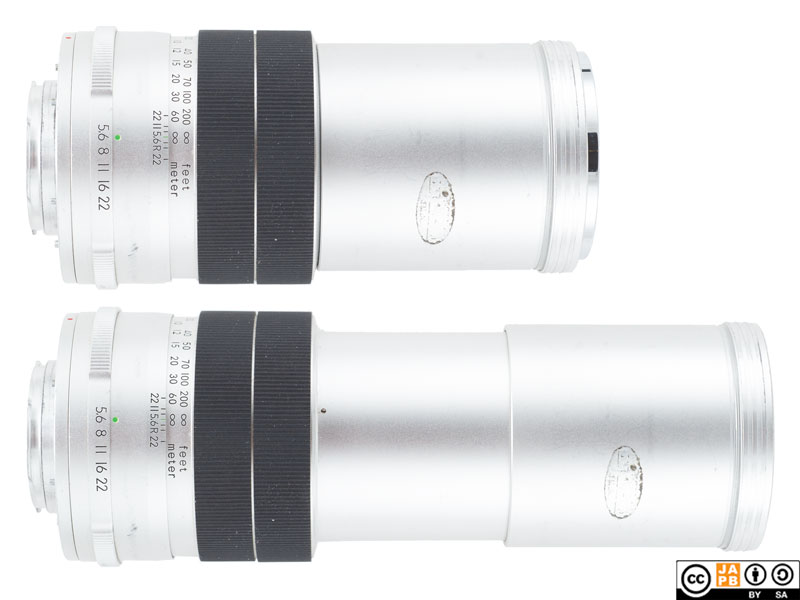Pekka Buttler, 03/2024

Specifications
The table below summarises the lens’ key specifications (measurements based on pictured version of the lens):
| Brand: | Tokyo Kogaku (Topcon) | Lens name | RE. Auto-Topcor 1:5.6 f=20cm |
| Focal length(s)1 | 200 mm | Angle-of-view2 | 12,3 ° |
| Maximum Aperture | f/5.6 | In Production | 1966–1977 |
| Lens mount (this lens) | Topcon/Exakta | Generation | RE. Auto-TOPCOR3 |
| Length4 | 127,0 mm | Diameter5 | 63,1 mm |
| Filter ring diameter | 49 mm | Weight | 451 grams |
| Lens element count | 5 | Lens group count | 4 |
| Aperture blades (S/R/C)6 | 6 S | Focus throw | 270 ° |
| Minimum focusing distance | 3 m | Maximum magnification | 1:11,5 |
| Has manual aperture ring | YES | Has Manual focus ring | YES |
| Aperture mechanism type | Auto | Aperture click stops 7 | 5.6•8•11•16•22 |
Further notes:
• With a maximum aperture of f/5.6, this lens is by no means a fast lens. On the other hand, with a total length of 127 mm and a weight of only 451 grams, it is very compact and light for a 200 mm lens.
• In an era when most lenses were uniformly black (and when even silver rings were going out of fashion), Topcon went in the opposite direction in the styling of their Topcon RE. Auto-TOPCOR series of lenses. These lenses were initially matte silver, with black rubber grips giving a contrast. However, after the 1971 introduction of the Super D, Topcon also started offering its lenses in black.
• In contrast to most Topcon RE. Auto-TOPCOR lenses of its era, this lens offers a built-in extendable lens hood (not a chromed bayonet for attaching a lens). Moreover, that lens hood offers a decent amount of extension, hence promising to actually be able to be useful (see below).
• The filter threads do not rotate on focusing.
• The aperture ring offers half-stop clicks throughout the range.

Bottom: Topcon RE. Auto-TOPCOR 200 mm f/5.6 with lens hood extended.
Versions and variations
The Topcon RE. Auto-TOPCOR 200 mm f/5.6 was not Topcon’s first 200 mm lens when it was introduced in 1966. It was preceded by a 200 mm f/4 design – a preset lens, that had been introduced all the way back in 1960. Interestingly, that earlier design was based on the Sonnar recipe and quite hefty, so this lighter and darker design was offered as a more compact, wallet-friendly alternative8.
The earliest samples (such as the pictured sample) of the 200 mm f/5.6 reported their focal length in centimetres. It is unclear when exactly this changed.

During the 10+ years this lens remained in production it was manufactured in silver (from 1966) and in black from (1972). I have found nothing to indicate that there would exist any optically significant variations.
History of Topcon
Unless you know your camera lore, you might not know that Topcon was once – between 1957 and 1976 – one of the foremost camera companies in the world.
You can read more details in the Topcon company profile.
Adapting
When intending to adapt Topcon/Exakta lenses keep in mind that most Topcon/Exakta lenses have control pins in the lens flange that vanilla Exakta lenses do not have. Hence, there is a theoretical possibility to that some old-time Exakta adapters have been manufactured that do not accommodate these pins. When procuring an adapter, make sure that it explicitly is compatible with Topcon lenses, or visually inspect the adapter regarding whether it makes room for the Topcon control pins.
With that caveat, the following applies to all Topcon/Exakta mount lenses.
This lens cannot be used natively on any current SLR or dSLRs. To use it in its native environment, you will need a Topcon RE Super film body or one of the subsequent Topcon cameras with the Topcon Exakta mount. While these were never produced in immense numbers, they seem to have stood the test of time reasonably well, and can still be found in perfectly serviceable condition.
Thanks to being a fully manual lens (manual aperture, manual focus), the lens can be adapted to all mirrorless cameras using a suitable ‘dumb adapter’. Moreover, due to the popularity of the Exakta mount, special adapters (helicoid adapters, tilt/shift adapters) are readily available.
Using Exakta mount lenses on dSLRs can also be an easy option, depending on the marque of dSLR.
• Canon EF has the shortest flange focal distance among full-frame dSLR’s and Canon’s wide range of dSLRs are able to mount Topcon/Exakta lenses perfectly using a simple adapter ring.
• Minolta / Sony A dSLRs, Pentax K and Nikon F mount dSLRs do not have a short enough flange focal distance to enable reaching infinity focus without an adapter that uses corrective optics.
Footnotes
- Focal length is (unless stated otherwise) given in absolute terms, and not in Full-frame equivalent. For an understanding of whether the lens is wide/tele, see ‘Angle-of-view’. ↩︎
- Picture angle is given in degrees (based on manufacturers’ specs) and concerns the diagonal picture angle. Rule of thumb:
> 90 ° ==> Ultra-wide-angle
70–90 ° ==> Wide-angle
50–70 ° ==> Moderate wide-angle
40–50 ° ==> ‘Standard’ or ‘normal’ lens
20–40 ° ==> Short tele lens
10-20 ° ==> Tele lens
5-10 ° ==> Long tele lens
< 5 ° ==> Ultra-tele lens ↩︎ - See more about Topcon lens generations in Topcon Company profile. ↩︎
- Length is given from the mount flange to the front of lens at infinity. ↩︎
- Diameter excludes protrusions such as rabbit ears or stop-down levers. ↩︎
- S=straight; R=rounded; C=(almost)circular at all apertures. ↩︎
- Numbers equal aperture values on aperture ring; • intermediate click; – no intermediate click. ↩︎
- Whether the older, preset variant remained in production past the introduction of this lens is unclear, but certainly a possibility. ↩︎